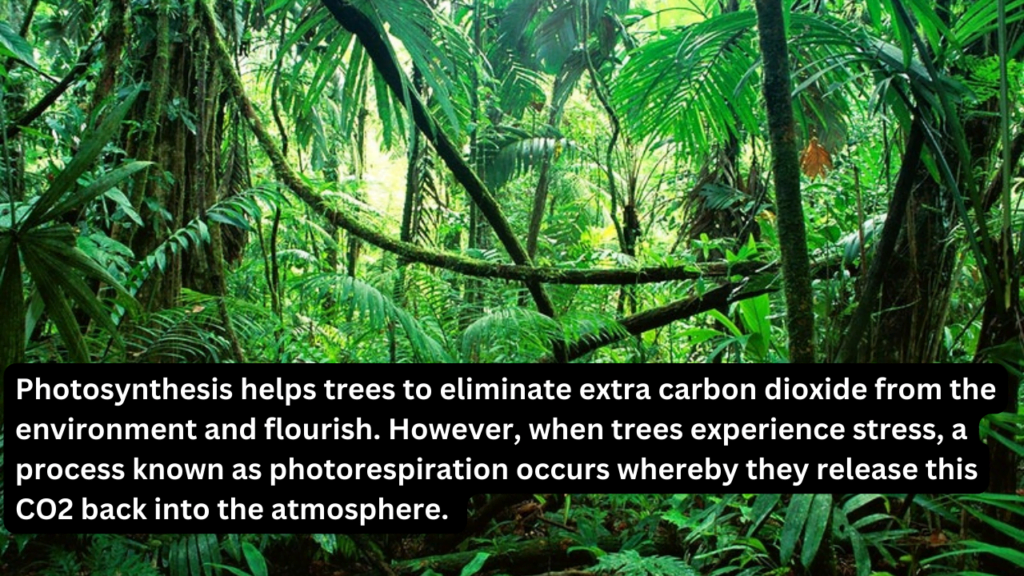It has been observed in research that trees in drier, warmer climates are incapable of capturing excess carbon dioxide, and are actually “coughing instead of breathing” because they are unable to cope with the air’s extreme concentration of carbon dioxide that has been trapped in heat.

Researchers headed by Max Lloyd, an assistant research professor of geosciences at Penn State, have found that trees’ ability to absorb extra CO2 decreases in hotter climates, making them incapable of reducing the harmful effects of climate change caused by human activity.
Even worse, they are returning significant amounts of extra carbon dioxide to the environment.
Trees, Photosynthesis, Photorespiration, and Carbon Dioxide – a relationship
The widely believed notion that trees and plants may assist mankind in lowering its carbon footprint is subverted by this alarming warning sign. The US Department of Energy estimates that plants absorb around 25% of the CO2 released into the atmosphere as a result of human activities, but experts now predict that percentage to decline sharply as global warming increases.
Lloyd, the lead author of a paper that was published in the Proceedings of the National Academy of Sciences journal, said in a statement, “We found that trees in warmer, drier climates are essentially coughing instead of breathing. They are sending carbon dioxide right back into the atmosphere far more than trees in cooler, wetter conditions.”
Photosynthesis helps trees to eliminate extra carbon dioxide from the environment and flourish. However, when trees experience stress, a process known as photorespiration occurs whereby they release this gas back into the atmosphere.
Lloyd and his colleagues discovered that the pace of this process is up to two times faster in warmer regions by evaluating tree tissue samples from all around the world. Additionally, they discovered that the more dry the climate, the more carbon dioxide the trees release.
It was found by the researchers that this impact is felt in any environment where daytime highs are higher than around 68 degrees Fahrenheit.
Lloyd added in the release, “We have knocked this essential cycle off balance. Plants and climate are inextricably linked.”
“The biggest drawdown of CO2 from our atmosphere is photosynthesizing organisms,” he continued. “It’s a big knob on the composition of the atmosphere, so that means small changes have a large impact.”
Read Related Article: UN Issues ‘Red Alert’ as Climate Change Pushes Globe Closer to 1.5C Limit

However, this equation may soon seem quite differently due to climate change.
“The world will be getting warmer, which means plants will be less able to draw down that CO2,” Lloyd further explained.
Now, the team plans to use ancient wood to investigate changes in photorespiration rates across tens of millions of years. This might test existing hypotheses about the historical and potential future capacities of CO2 photosynthesizing organisms to absorb.
Lloyd added in the statement, “I’m a geologist; I worked in the past.” “So, if we’re interested in these big questions about how this cycle worked when the climate was very different than today, we can’t use living plants.”
“We may have to go back millions of years to better understand what our future might look like,” he added.
Trees are invaluable friends in the battle against climate change due to their inherent ability to absorb carbon dioxide. They absorb CO2 and release oxygen into the atmosphere through photosynthesis, therefore lowering the atmospheric concentration of greenhouse gases.
This synergetic interaction is essential for the environment to remain balanced and to fight global warming. But the ability of trees to absorb CO2 is being strained as a result of human activity’s ongoing growth in carbon dioxide emissions. This demonstrates why protecting and growing forest areas is so important as a mitigation strategy for climate change.
Preserving trees is essential to maintaining the health of our world and ensuring a sustainable future.






